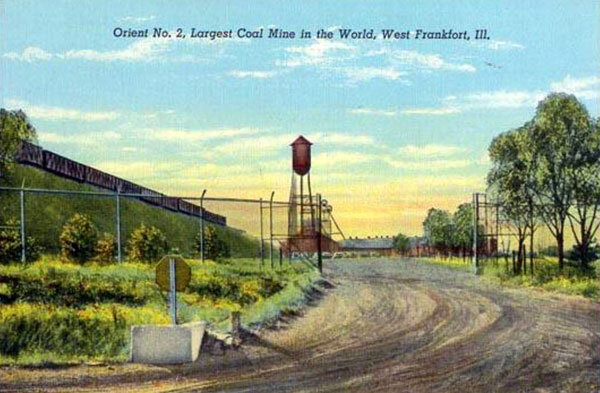Mine Disaster of 1951
The New Orient Coal Mine Disaster of 1951
Written by Ashley Jones
Anna-Jonesboro Community High School
December 21, 1951, began no differently than any other pre-Christmas day in the rural coal mining town of West Frankfort, Illinois. Everyone seemed to be in the Christmas spirit, especially the night shift workers of the Orient Coal Mine who were about to descend into the depths of the earth at 6:00 in the evening. Greeting them on a chalkboard outside the entrance of the mine was a message scripted: "Merry Christmas to the Night Crew." This was to be the last shift before the miners' Christmas vacation.
At approximately 7:40 P.M. all were busy doing their specified jobs when the blast occurred. Wilfred McDaniels, the night mine manager, was on top at the time checking his records for the shift, when he received the news that the power was off and there had to be something wrong because there was a lot of dust coming from the shafts. He immediately called John Foster, the superintendent of the mine; Arlie Cook, the mine manager, and the mine rescue crews. Tommy Haley, a repairman, called in from the telephone located in one of the sections of the mine and told McDaniels, "Something terrible has happened." The 133 uninjured miners from the unaffected sections of the mine headed for the surface.
Immediately following the phone call, 2,000 of the town's citizens were informed over the loud speaker at the local high school's basketball game about the explosion. Family members quickly rushed to the site anxiously waiting to hear the outcome. More than 218 rescue men worked through the night, but the miners themselves, who made it out alive, held little hope that any of the trapped men were alive. As rescuers were recovering dead bodies, they used the local junior high school gymnasium as a temporary morgue. The only survivor of the 120 that were trapped was a man named Cecil Sanders. He endured a harsh and cold sixty hours trapped in the mine after the explosion. Sanders was reported as having enough carbon monoxide in his lungs to have killed any ordinary man, but according to the local physician, Sanders was far from ordinary since he was so used to the mining atmosphere. He was West Frankfort's own Christmas miracle. On Christmas Eve the death toll had reached 119 and the search for the cause of the explosion was underway. Federal, state, and company inspectors worked endlessly until December 27 trying to find out what caused this terrible accident.
Illinois Mines Director Walter Eadie said, "The explosion at the mine was definitely caused by methane gas." Federal inspectors had previously criticized some of the means employed by the company to control methane, but the company had ignored those federal recommendations. James Westfield, a United States Bureau of Miners official called the disaster "somebody's carelessness and an absolutely avoidable accident." Altogether, the inspectors found thirty-one violations of the Federal mine safety code. Many were relatively minor, but some were of such a nature as to "indicate serious hazards similar to those that had caused heavy loss of life or destruction of property."
This disaster, along with many others such as the Cherry Mine Disaster in Cherry, Illinois, and the Centralia Mine Disaster in Centralia, Illinois, attracted national attention due to the lack of proper ventilation systems. On July 16, 1952, President Harry S. Truman signed the Federal Coal Mine Safety Act. This Act authorized mine inspectors to require any mine employing fifteen men or more to comply with mine safety provisions. This act allowed the federal government to shut down any mines that it thought were potentially dangerous. This gave the mine inspectors power to enforce the laws on any mine who did not meet the standards of the Safety Act. These new laws enforced mines to become better ventilated to control the methane gas. It also helped control the floating coal dust by dusting the mine walls with a limestone compound. The Safety Act has been so effective that there has been only one other mine disaster in southern Illinois since it was passed.
The New Orient coal mine disaster of 1951 helped change mining history. This disaster helped the government realize that Illinois needed stricter safety regulations, and these stricter safety regulations saved lives. Due to the Federal Coal Mine Safety Act of 1952, mining became safer for all of Illinois' coal laborers.
"Christmas Ended That Night" by Jim Muir
"The Orient No. 2 Coal Mine Explosion" by Desiree Southern Ratay



